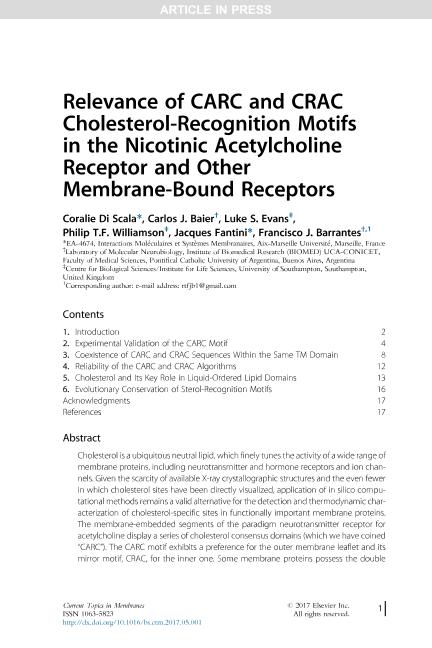Artículo
Relevance of CARC and CRAC Cholesterol-Recognition Motifs in the Nicotinic Acetylcholine Receptor and Other Membrane-Bound Receptors
Di Scala, Coralie; Baier, Carlos Javier ; Evans, Luke S.; Williamson, Philip T. F.; Fantini, Jacques; Barrantes, Francisco Jose
; Evans, Luke S.; Williamson, Philip T. F.; Fantini, Jacques; Barrantes, Francisco Jose
 ; Evans, Luke S.; Williamson, Philip T. F.; Fantini, Jacques; Barrantes, Francisco Jose
; Evans, Luke S.; Williamson, Philip T. F.; Fantini, Jacques; Barrantes, Francisco Jose
Fecha de publicación:
07/2017
Editorial:
Elsevier Academic Press Inc
Revista:
Current Topics In Membranes
ISSN:
1063-5823
Idioma:
Inglés
Tipo de recurso:
Artículo publicado
Clasificación temática:
Resumen
Cholesterol is a ubiquitous neutral lipid, which finely tunes the activity of a wide range of membrane proteins, including neurotransmitter and hormone receptors and ion channels. Given the scarcity of available X-ray crystallographic structures and the even fewer in which cholesterol sites have been directly visualized, application of in silico computational methods remains a valid alternative for the detection and thermodynamic characterization of cholesterol-specific sites in functionally important membrane proteins. The membrane-embedded segments of the paradigm neurotransmitter receptor for acetylcholine display a series of cholesterol consensus domains (which we have coined “CARC”). The CARC motif exhibits a preference for the outer membrane leaflet and its mirror motif, CRAC, for the inner one. Some membrane proteins possess the double CARC–CRAC sequences within the same transmembrane domain. In addition to in silico molecular modeling, the affinity, concentration dependence, and specificity of the cholesterol-recognition motif–protein interaction have recently found experimental validation in other biophysical approaches like monolayer techniques and nuclear magnetic resonance spectroscopy. From the combined studies, it becomes apparent that the CARC motif is now more firmly established as a high-affinity cholesterol-binding domain for membrane-bound receptors and remarkably conserved along phylogenetic evolution.
Palabras clave:
Carc Motif
,
Cholesterol
,
Crac Motif
,
Ion Channels
,
Neurotransmitter Receptor
Archivos asociados
Licencia
Identificadores
Colecciones
Articulos(INIBIBB)
Articulos de INST.DE INVEST.BIOQUIMICAS BAHIA BLANCA (I)
Articulos de INST.DE INVEST.BIOQUIMICAS BAHIA BLANCA (I)
Citación
Di Scala, Coralie; Baier, Carlos Javier; Evans, Luke S.; Williamson, Philip T. F.; Fantini, Jacques; et al.; Relevance of CARC and CRAC Cholesterol-Recognition Motifs in the Nicotinic Acetylcholine Receptor and Other Membrane-Bound Receptors; Elsevier Academic Press Inc; Current Topics In Membranes; 80; 7-2017; 3-23
Compartir
Altmétricas



